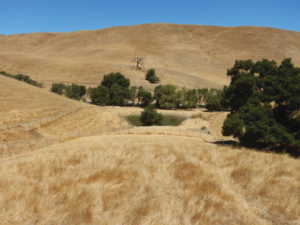


Area: 27.16 acres
Location: Santa Cruz County, California
Date Acquired: January 2018
Acquisition Type: CNLM holds a conservation easement as well as a long-term agreement to protect the imperiled species and their habitats on the preserve. The preserve is owned by third party.
Key Habitats: Annual grassland, Coastal oak woodland, Freshwater aquatic/wetland and Valley foothill riparian
Species of Special Interest to CNLM: California red-legged frog (Rana draytonii) and California tiger salamander (Ambystoma californiense)
Introduction
The Shingle Creek Preserve consists of approximately 27.16 acres located in the northwest portion of the 3,289-acre United Technologies Corporation, Pratt & Whitney (UTC-PW) Facility in unincorporated Santa Clara County. The Preserve serves as mitigation for the temporary loss of CTS upland habitat. UTC-PW owns the property. The 5,200-acre Site was operated as a solid propellant rocket research, manufacturing and testing facility from 1959 to 2004. The Facility has been undergoing a Site Closure Program (SCP) that involves the demolition of the site industrial infrastructure and remediation of site soil, groundwater and surface water. The Preserve has been protected in perpetuity as part of activities conducted for the SCP. The Center for Natural Lands Management (CNLM) holds a conservation easement over the property and is responsible for perpetual management. The purpose of the conservation easements is to help ensure that the property will be retained in perpetuity in open space condition and to prevent use of the property that will impair or interfere with the conservation values of the Preserve. CNLM is responsible for the perpetual care of the Preserve, ensuring the habitat remains healthy for the imperiled species, meeting all conservation easement obligations.
Conservation Significance
 The dominant vegetation type on the Preserve (~23.05 acres) is non-native grassland. No special-status plant species have been observed. This type of vegetation is compatible with the habitat requirements of California red-legged frog (CRLF) and California tiger salamander (CTS). To maintain appropriate vegetation structure, a grazing operator is engaged. In fact, this area has been grazed (with the same grazing operator) since 1960.
The dominant vegetation type on the Preserve (~23.05 acres) is non-native grassland. No special-status plant species have been observed. This type of vegetation is compatible with the habitat requirements of California red-legged frog (CRLF) and California tiger salamander (CTS). To maintain appropriate vegetation structure, a grazing operator is engaged. In fact, this area has been grazed (with the same grazing operator) since 1960.
A man-made stock pond (Pond 8) along a tributary to Shingle Creek is a key feature in supporting CRLF and CTS on this preserve. The pond covers an area of approximately 0.16-acres. It is more than 5 feet deep when full and typically holds water year-round, although it dried completely during drought conditions in 2014. It was fenced to exclude cattle in 2007. However, because of a buildup of thatch, the gate was opened recently to allow cattle to graze in the Pond 8 area. The pond supports freshwater marsh habitat. A sizeable live oak tree and willow are growing on the south shore.
Two small streams supporting oak woodland/riparian habitat are present in steep-walled ravines. Surface flow in the East Tributary bypasses Pond 8 and is present only during and immediately following significant rain events. The West Tributary has two branches and flows into Pond 8. There is one seep located upstream of Pond 8. A spring is present in the West Tributary near the upper end of riparian vegetation. Pond 8 spills into the East Tributary, which runs approximately 150 feet to the northeast before joining Shingle Creek. Shingle Creek, an intermittent stream at this location in the watershed, passes through the northeast corner of the Preserve. The pond supports successful breeding habitat for both CTS and CRLF. The upland grassland habitat contains small mammal burrows which provide refuge for CTS and CRLF, among other species.
Our Work
The overall goal is to manage the Preserve to maintain and sustain its biological functions and conservation values particularly towards recovery of the federal- and state-threatened California tiger salamander. Emphasis for management is at Pond 8, which is a breeding pond for the species. Management actions will be taken to maintain pond conditions that provide standing water during CTS breeding and larval development season (i.e., December through June). Monitoring will include regular assessments of the flora and fauna to help guide management decisions. Management will include regular (conservation easement) enforcement and trash pick-up. Management activities will also include invasive plant control and use restrictions to sustain suitable habitat conditions for the listed species. The grassland vegetation will be managed to encourage use by burrowing mammals to provide refuge to CTS and other animals.
Public Access
Due to the vulnerability of the species and habitats that exist on this preserve, it is not open to the public.
Contact
For information on Shingle Creek or Center for Natural Lands Management please contact Cathy Little, Regional Preserve Manager at clittle@cnlm.org or 760.731.7790 extension 209

